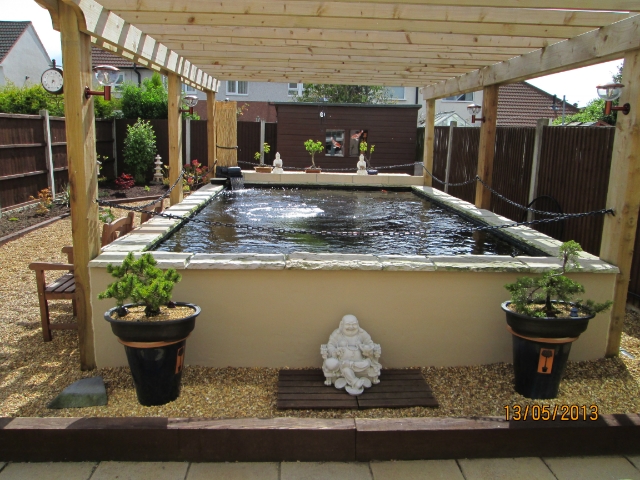Brian Woodcock
from the United Kingdom comes to mind as someone that fits the description of a
hobbyist that does his work more like he’s being paid to do it as a
professional. What he needed to do was integrate an Anoxic Filter to his
already existing formal pond and make it blend into his garden, English with a
flavor of Japanese mixed in. At the moment he has a 6200-gal (Don’t know if
that is imperil or US gallons) fiberglass pond with sieve and bead filter as
his maim filtration with a Clarity type filter with 100-ltr O.D. Bio-pore
medium being use. On top of this he’s added a 110-watt UV Filter/clarifier for
bacteria eradication and to help in turbidity of his pond along with a 6-kw
heater for stability of water temps.
He has
generously offered to show in detail his Anoxic Filtration build in pictures
from the UK. As the Chinese say: “one picture is worth a thousand words.”
There are many pond
filtration systems that are easy to build like Veggie Filters, Bog Filters,
Drum Filters and Bakki Shower Filters that all fall under the DYF and can be a
considerable cost savings to the hobbyist. By understand an Anoxic Filters
dynamics, you then will realize that Veggie and Bog Filters are incorrectly
implemented or incorrectly built altogether. Bog Filters are nothing like real
bogs at all, and if you were to try and filter your pond with an acidic bog
filter like in a Natural environment, your animals’ wouldn’t survive very long.
Just because you place a lot of stones or pea-gravel at the bottom of a pond
and then add a few plants to it, doesn’t make it a bog at all. If you think
that biological and chemical pathway will remain open to chemical mediators by
the convection of plants; well you would be sadly mistaken. The intersection of
topography is no longer available because of the ponds liner.
Tests have shown that water movement through the substrate is too unreliable with just plants alone. Plants can only do so much and without proper root hair proliferation that only grows with proper macro and micro (The Liebig Minimum Law dictates that.) trace elements like Iron and Manganese (thats whats in Laterite) to name a few; it will not do what you think it will. If you think that pulling the water through the substrate by mechanical means is better and more reliable than plants alone, then you have just made another mechanical filter that has to be cleaned. Pulling water through the substrate just won’t pull water through it, but also any detritus along with it. Don’t over estimate that plants will take everything that comes into your filter as food, they will not! Plants look for an easy ion uptake like ammonia (NH3) first, because Nitrates are too much work. Nitrates have to be converted back into NH3 before the plant can use it as food and that’s chemical work it rather not do using too much of the plants energy and cutting back on photosynthesis.
Tests have shown that water movement through the substrate is too unreliable with just plants alone. Plants can only do so much and without proper root hair proliferation that only grows with proper macro and micro (The Liebig Minimum Law dictates that.) trace elements like Iron and Manganese (thats whats in Laterite) to name a few; it will not do what you think it will. If you think that pulling the water through the substrate by mechanical means is better and more reliable than plants alone, then you have just made another mechanical filter that has to be cleaned. Pulling water through the substrate just won’t pull water through it, but also any detritus along with it. Don’t over estimate that plants will take everything that comes into your filter as food, they will not! Plants look for an easy ion uptake like ammonia (NH3) first, because Nitrates are too much work. Nitrates have to be converted back into NH3 before the plant can use it as food and that’s chemical work it rather not do using too much of the plants energy and cutting back on photosynthesis.
Note from ED: Anoxic Filters are not plant reliant but if
plants are added to the Biocenosis Baskets you will soon discover what Justus
Liebig meant by a plant only will grow as good as its limiting factor. A
Biocenosis Basket is a perfect environment for plants. It allows a safe
environment for bacteria and the proliferation of plant root hairs that you
never hear about, without the limiting of available foodstuff into the baskets by clogging like other filter.
 |
| Brian's pond without the Anoxic Filter added on. Big ponds like this one need the best filtration a hobbyist can give their Koi. |
 |
| Brian started out with a BluePrint of the Anoxic Filters integration first. |
A box-weld liner was used instead of the conventional liner to minimize folds.
Bottom photo shows a diffuser using 2" and 4" pipe with 6-mm holes drilled in the 4" pipe as explained in my book.
 |
| This photo shows everything fitted with bottom drain for easy clean-out of Anoxic Filter when needed.The Anoxic Filter is about 4” higher than the existing pond
and will spill out into the main pond via waterfall. The filter itself is
300-gals and will hold 24@ 30X30 cm Biocenosis baskets in it. Brian is now waiting for his plant baskets and will finish the filter to look more like the rest of his pond. Will keep everyone up to date on his build when he sends me more info on his Anoxic build.
Anoxic Filtration Book... Still free
on Apple's iBook store
https://itunes.apple.com/us/book/ano...04698627?mt=11
|








No comments:
Post a Comment